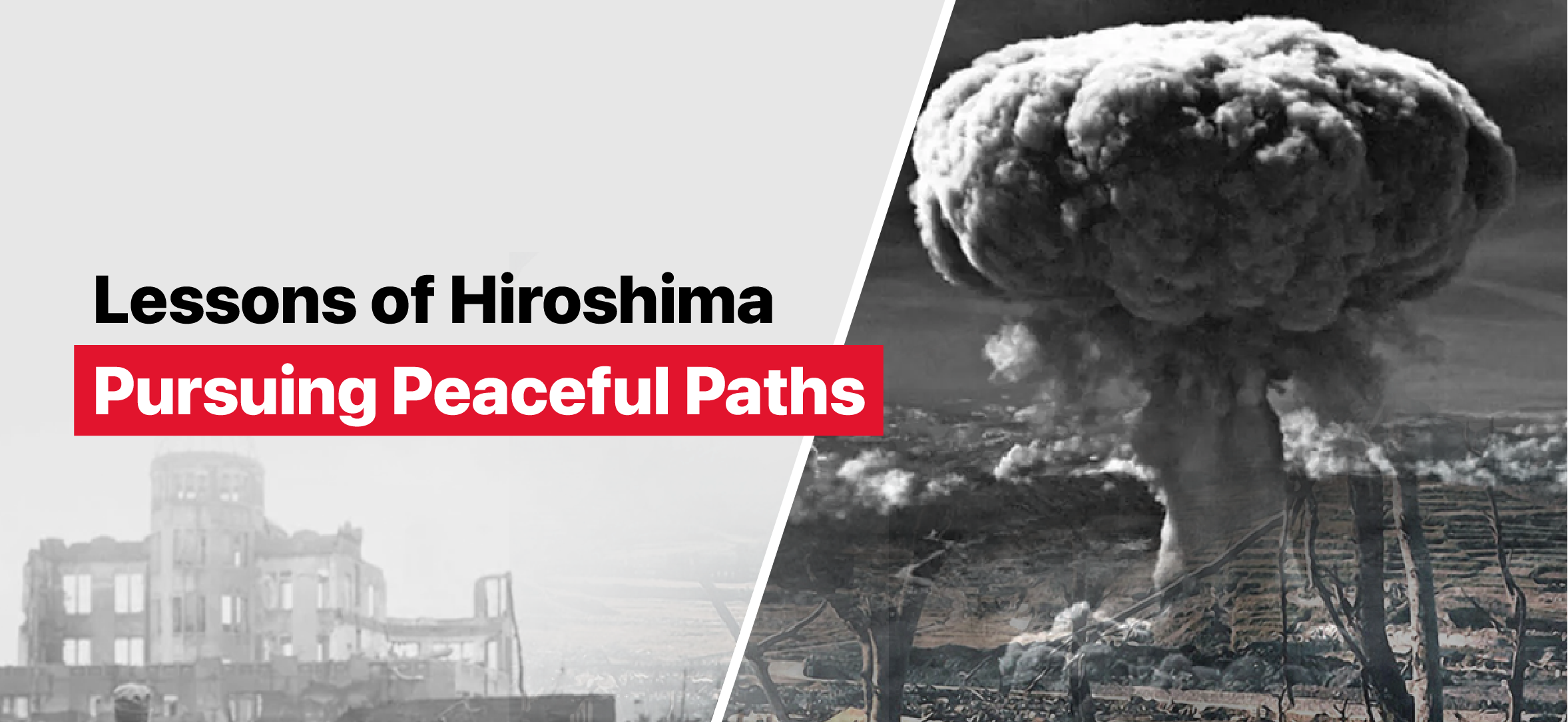Lessons of Hiroshima: Pursuing Peaceful Paths
Blogs Home
- 07 Aug 2023

Situated on Honshu Island in Japan, Hiroshima took a pivotal position in world history during the Second World War. It served as a significant military hub, containing crucial army bases and naval establishments, and acted as a vital supply node for the Japanese Imperial Army. This strategic importance made it a desirable target during the war, culminating in its devastating obliteration on August 6, 1945.
Up until this catastrophic day, Hiroshima had avoided the extensive air raids that many other Japanese cities had endured. This was intentional, as the United States had specifically refrained from attacking Hiroshima and a few other cities to accurately gauge the effect of the novel weapon that would forever alter global dynamics.
The global dispute known as World War II, involving over 30 countries, had been raging since 1939. Following the unexpected assault on Pearl Harbor by Japanese forces in December 1941, the United States officially joined the conflict.
While the Allies were gaining ground in Europe, the Pacific was still a hotly contested battleground. The tenacious resistance of the Japanese forces and the high casualty rates on both sides spurred a new strategy to bring the conflict to a swift conclusion.
Amid this grave situation, the Manhattan Project—the United States' highly confidential endeavor to develop an atomic bomb—was rapidly progressing. After years of research and a considerable financial commitment, the project achieved success in July 1945 when the first successful test, codenamed "Trinity," was executed.
Now armed with an unimaginably powerful weapon, the Allies issued the Potsdam Declaration on July 26, demanding Japan's unconditional surrender. Japan's noncompliance set the stage for the impending tragedy.
On the morning of August 6, 1945, the US bomber Enola Gay released "Little Boy," the first atomic bomb ever used in combat, over Hiroshima. In an instant, the city was annihilated, and approximately 140,000 people were immediately killed or later died from injuries and radiation illness.
This unparalleled devastation was followed by a second atomic attack on Nagasaki three days later, resulting in Japan's unconditional surrender on August 15, 1945, effectively concluding World War II.
The bombing of Hiroshima marked a crucial turning point in global history. It concluded the deadliest conflict ever witnessed by humankind and initiated the Atomic Age, a period characterized by the existence of nuclear weapons and the existential threat they pose.
The horrifying effects of the atomic bombings on Hiroshima and Nagasaki played a substantial role in shaping the global attitude toward nuclear weapons. It led to a consensus on the significance of nuclear disarmament and non-proliferation, albeit often challenged by geopolitical circumstances.
The bombing also led to the formation of the international legal framework (Geneva Conventions, 1949) relating to warfare conduct and civilian protection. The indiscriminate nature of nuclear weapons has made their use a subject of rigorous debate and scrutiny under international humanitarian law.
Furthermore, Hiroshima's reconstruction from the rubble symbolized human resilience. Today, the city stands as a monument to peace, with the Hiroshima Peace Memorial Park at its heart, reminding the world of the tragic outcomes of nuclear warfare.
Shaping International Relations and the Nuclear Arms Race
The bombing of Hiroshima not only signaled the end of World War II but also had a profound impact on the trajectory of international relations and diplomacy. The sheer extent of the destruction, followed by Japan's swift surrender, showcased to the world the terrifying capabilities of nuclear weapons.
This event was deeply etched into global consciousness, triggering a shift in power dynamics and heralding the beginning of the nuclear arms race. The two emerging superpowers of the post-war era, the United States and the Soviet Union found themselves in a competition for nuclear dominance, defining the decades-long tension known as the Cold War.
The bipolar world order created an environment of apprehension and anxiety. Although the two superpowers never directly engaged in large-scale warfare, their political, ideological, and military standoffs, coupled with the ever-looming nuclear threat, led to numerous proxy wars and brinkmanship scenarios.
Among the first and most significant nuclear policies was the Treaty on the Non-Proliferation of Nuclear Weapons (NPT) signed in 1968. The treaty aimed to prevent the spread of nuclear weapons and technology, promote cooperation in peaceful nuclear energy uses, and advance the goal of nuclear disarmanship.
Over time, other agreements and treaties such as the Comprehensive Nuclear-Test-Ban Treaty (CTBT) and the Treaty on the Prohibition of Nuclear Weapons (TPNW) have added to the international legal framework seeking to regulate nuclear weapon use. These efforts highlight the global community's dedication to avoiding the recurrence of the Hiroshima and Nagasaki tragedies.
Global Conflict Resolution and Peacekeeping Studies
Nuclear armaments present an existential menace to humankind. Their colossal destructive power, the indiscriminate nature of their impact, and the extended environmental damage they inflict render their use potentially catastrophic on a global scale. As such, the incidents of Hiroshima and Nagasaki have underscored the importance of nuclear disarmament and non-proliferation in safeguarding world peace.
In the aftermath of World War II, the worldwide community has taken considerable strides toward curbing the proliferation and prospective use of nuclear weapons. Initiatives have been undertaken on multilateral fronts, culminating in the formation of agreements such as the NPT, CTBT and TPNW. These accords have played a vital role in restraining the nuclear arms race and contributing to international security.
However, the task is far from complete. As long as nuclear weapons exist, the threat of nuclear warfare persists. Therefore, the objective of total nuclear disarmament, while demanding, is essential for ensuring the long-term safety and peace of our world. This aim requires the cooperation and commitment of all nations, especially those possessing nuclear weapons.
Nuclear Weapons from Ethical and Humanitarian Perspectives
This immense loss of life and the wider humanitarian impact of the Hiroshima bombing highlighted the ethical implications of warfare, particularly the use of weapons of mass destruction. It intensified discussions around the responsibility of nations to protect civilians during armed conflicts—a cornerstone of international humanitarian law.
International humanitarian law, also known as the Law of War, stipulates that parties involved in an armed conflict must differentiate between combatants and civilians. It prohibits the use of weapons or tactics that may cause excessive harm or unnecessary suffering, especially to civilians. The bombing of Hiroshima raised serious questions about whether the use of such a destructive weapon could ever comply with these principles, prompting widespread debates on the moral dimensions of nuclear warfare.
The nuclear bombings of Hiroshima and Nagasaki remain the only instances of nuclear weapons use in warfare, and they have incited complex moral and ethical debates that continue to this day. Some posit that the bombings accelerated the end of World War II, potentially saving more lives than they claimed by preventing a protracted war. Others counter that the immense human suffering and the indiscriminate nature of nuclear weapons render their use fundamentally unethical, regardless of the circumstances.
These differing viewpoints underscore the inherent moral complexity of nuclear weapons. Even as we grapple with these difficult ethical questions, the tragic human cost witnessed in Hiroshima offers a sobering reminder of the potential consequences of resorting to such devastating means. It underlines the urgency of fostering peace, reducing arms, and continually striving for a world in which the use of such destructive weapons becomes unnecessary and unthinkable.
Significance in Contemporary Global Affairs
The insights gleaned from Hiroshima continue to resonate in the contemporary international climate. Despite the Cold War's conclusion, nuclear weapons persist in posing major threats to international peace and safety. Today, nine nations possess nuclear weaponry, and several others have the technological capabilities to manufacture them. Additionally, the potential of non-state entities, including terrorist organizations, to acquire nuclear materials remains a grave concern.
The diffusion of nuclear weaponry and the modernization of nuclear arsenals by various nations present significant challenges to the global non-proliferation framework. Regional conflicts and geopolitical frictions, from the Korean Peninsula to the Middle East, heighten concerns regarding the possible deployment of nuclear weaponry. These situations necessitate robust diplomatic efforts and potent conflict resolution methodologies to prevent escalation and sustain stability.
On a hopeful note, there have also been substantial advancements in the domain of nuclear disarmament and peace initiatives. For example, the Treaty on the Prohibition of Nuclear Weapons, which became effective in January 2021, signifies a significant progression in international efforts toward nuclear disarmament. The treaty, endorsed by the United Nations, prohibits the development, testing, production, stockpiling, stationing, transfer, use, and threat of use of nuclear weapons.
Additionally, the world has witnessed several successful examples of nuclear disarmament. Nations such as South Africa, Belarus, Kazakhstan, and Ukraine have voluntarily relinquished their nuclear weapons programs or surrendered their nuclear stockpiles. These instances underscore that progress is achievable and strengthen the potential for a world devoid of the menace of nuclear weapons. However, for these initiatives to prosper, consistent commitment from all nations, particularly the nuclear-armed states, is vital.
Leadership and Decision-making During Crisis
Key arguments in favor of the bombing included the belief that it would hasten Japan's surrender, save American and Allied lives by avoiding a protracted ground invasion, and demonstrate the power of the US to the world, particularly the Soviet Union. However, these considerations were weighed against the profound moral and ethical issues involved in using a weapon of such devastating power.
The decision was ultimately taken by President Harry S. Truman and his advisers, who believed that the use of the atomic bomb was the best option available to bring the war to a swift conclusion. This decision, and its horrifying consequences, continue to spark intense debate among historians and ethicists, reflecting the difficult moral, strategic, and political dilemmas faced by leaders during times of crisis.
Promoting peace during times of crisis requires leadership qualities such as foresight, empathy, and the ability to negotiate and compromise. It involves the capacity to foresee potential threats and conflicts and take proactive measures to address them. Leaders must also have the empathy to understand the perspectives of different stakeholders, including both allies and adversaries and strive to address their concerns in a fair and balanced manner.
Epilogue
The haunting legacy of Hiroshima continues to shape our world, reminding us of the destructive potential of nuclear warfare and the importance of peace. The lessons we have learned from this tragic event should guide our efforts to promote diplomacy, disarmament, and conflict resolution in the face of contemporary challenges. As we navigate the complexities of the 21st century, let us strive to embody the leadership qualities that can transform crises into opportunities for peace and progress. For it is only through such efforts that we can hope to prevent the repetition of tragedies like Hiroshima, safeguard our shared humanity, and build a safer and more peaceful world for generations to come.
Sources:
https://www.un.org/en/global-issues/disarmament
https://www.armscontrol.org/factsheets/INFtreaty
https://www.un.org/en/global-issues/disarmament
https://history.state.gov/milestones/1961-1968/npt
Shounak Roy

He finds pleasure in the hunt for knowledge, eagerly seeking to learn something new about anything that interests him. He describes himself as a simple and peaceful individual, always curious to delve deeper into various subjects. If he comes across someone with shared interests, he enjoys engaging in discussions and exchanging knowledge.
Blogs Home



